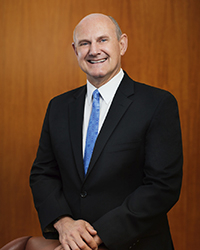
Mark Warner, MD
COVID-19 has affected every conceivable facet of the heath care industry, but few have been affected more than anesthesiology. This fact informs one of the key “lessons learned” that will be featured during the Saturday session “Anesthesia Patient Safety Foundation Panel: Ten Patient Safety Issues We’ve Learned from the COVID Pandemic.”
According to session moderator and APSF President Mark Warner, MD, of the Mayo Clinic in Rochester, Minnesota, the APSF annually compiles a “Top 10” patient safety list. It’s used to drive education, targeted research, and practice initiatives each year. This year, the COVID-19 pandemic fell within one of APSF’s priority patient safety issues: Hospital-Acquired Infections and Environmental Microbial Contamination and Transmission.
“APSF’s directors work in unique facilities and reflect the diversity of clinical practices across the country,” Dr. Warner said. “Their insights into the COVID-19 pandemic and the key lessons each has learned lead to fascinating and clinically relevant information that is useful to all anesthesiologists and other anesthesia professionals.”
For example, Dr. Warner said, APSF’s Chair of the Committee on Technology, Jeff Feldman, MD, of the Children’s Hospital of Philadelphia, played a major role nationally in helping anesthesiologists, intensivists, and respiratory therapists understand the differences between ICU ventilators and anesthesia ventilators. It was an important distinction during peak periods of need for ventilators early in the onset of the pandemic in the U.S. and elsewhere.
Anesthesia Patient Safety Foundation Panel: Ten Patient Safety Issues We’ve Learned from the COVID Pandemic
1-2 p.m. CT
Saturday
Another lesson was the importance of simulation. According to session presenter Steve Howard, MD, of Stanford University School of Medicine in Palo Alto, California, simulation has “advanced anesthesia patient safety over the last 25 years.” Earlier this year, Dr. Howard said, simulation was widely used to prepare health care providers for treating patients with COVID19, as “anesthesiologists and other anesthesia professionals again led the way for much of health care.”
The pandemic has taken its toll on the emotional well-being of anesthesiologists. Matt Weinger, MD, MS, of Vanderbilt University Medical Center in Nashville, said the biggest lesson learned was “don’t neglect the clinician’s well-being.”
“Don’t assume that existing organizational processes and structures will be sufficient or responsive to address anesthesia professionals’ needs in the face of a major disrupter such as COVID-19,” Dr. Weinger said. “That generates massive uncertainty, stress, and fear.”
Consider the impact of isolation, too, said anesthesiologist Della M. Lin, MD, FASA, who is in private practice in Honolulu. Physician isolation can threaten patient safety, she said. Physicians must create psychological safety within their teams and intentionally focus on patients as a team.
One method of reducing physician burnout in a pandemic is to manage the “info-demic,” or information overload, according to Meghan Lane-Fall, MD, MS, of the Hospital of the University of Pennsylvania in Philadelphia. Dr. Lane-Fall said it is useful to “pre-digest information for busy clinicians so they are able to process and use clinically relevant information,” while engaging in frequent communication from a trusted source.
There have been some silver linings, including multidisciplinary unity. Steven B. Greenberg, MD, of Evanston Northwestern Hospital in Evanston, Illinois, said health care professionals have worked together, globally, to provide the appropriate staffing models and the appropriate education for those who were called upon to care for COVID-19 patients.
Also included in the session will be a discussion of the importance of national guidelines, presented by Dan Cole, MD, FASA, of Ronald Reagan UCLA Medical Center in Los Angeles; exploring what to consider when reading COVID-related scientific articles early during the pandemic, presented by Richard C. Prielipp, MD, MBA, of the University of Minnesota Health Center in Minneapolis; and a discussion of “Circle up!,” led by May C. Pian-Smith, MD, of Harvard Medical School-Massachusetts General Hospital in Boston. Circle Up! is a framework for communication and care that was developed at MGH for medical simulation.
Ultimately, according to Marjorie Stiegler, MD, of the University of North Carolina in Chapel Hill, a key response to chaos is to stimulate creativity without sacrificing patient safety.
“Anesthesiologists and other anesthesia professionals are famous for creativity, problem solving, and resourcefulness – especially in limited resource situations,” Dr. Stiegler said. “This is laudable, but shouldn’t be a catalyst that undermines safety culture at the institutional (or national) level.”
Return to Index